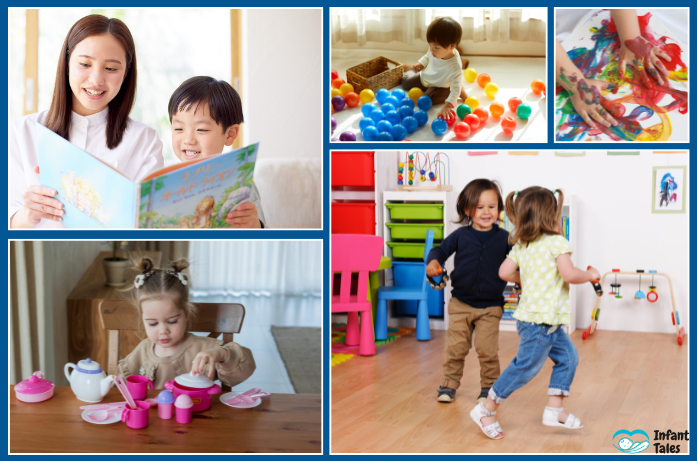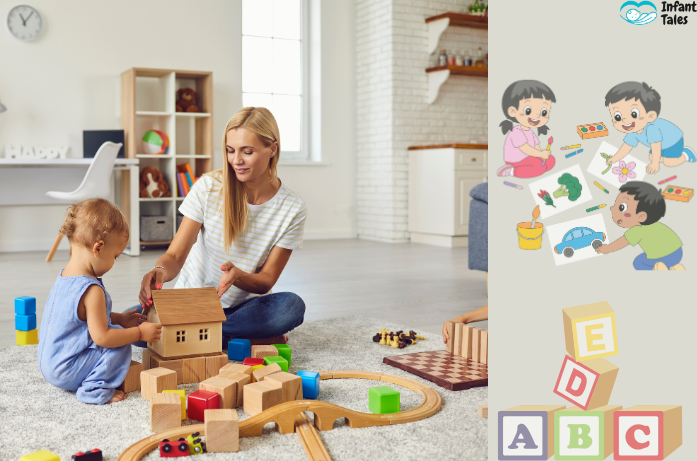A trusted guide from the Infant Tales Team
Raising a toddler turns out to be an adventure infused with sheer curiosity, orgasmic laughter, and a little bit of discovery. During early life, toddlers are like little sponges, absorbing every sound, sight, and experience around them. Best part? Development can be nurtured with the kiddo through simple programs or activities at home from some simple Toddler Learning Activities. As they go through these activities, the children further the development of important skills, their creative sides, and bunches of treasured memories, all wrapped in fun.
Let us, then, undertake this journey to look into simple and fun activities that can stimulate a toddler’s brain and can easily be incorporated into everyday life by families and caregivers. These activities for toddlers learning are meant to develop problem-solving skills, building motor skills, language skills, and building up the imagination, all while promoting fun learning in everyday life.
Why Learning at Home Matters
The toddler years (ages 1–3) represent a critical stage for brain development. Child developmental studies show that, at this stage, more than one million neural connections are being formed per second. Play activities serve as early life experiences that influence social, emotional, physical, and cognitive developments of the toddlers.
When parents and toddlers spend time together doing academic activities at home, it doesn’t just prepare toddlers for preschool; it strengthens the parent and child bonding, stimulates curiosity, and seeds a lifelong mentality of learning, (CDC’s Positive Parenting Tips for Toddlers)

Fun and Educational Toddler Learning Activities at Home
Below is a list of activities that combine fun and development and can be easily fitted into daily routines.
1. Sensory Play Adventures
Toddlers learn best when all their senses are engaged. Such knowledge helped in developing sensory activities for toddlers so that they can explore the textures, colors, sounds, and smells that build initial brain connections.
- Rice or Pasta Bin: Create a rice or pasta bin, add hidden toys and give your toddler cups or spoons to scoop, pour, and explore.
- Water Play: A bowl of water and cups, spoons, and floating toys helps them find out things about sinking, floating, and pouring.
- Playdough Creations: Rolling, squishing, and shaping playdough works those hand muscles and stretches imagination.
What happens in this: Sensory play helps a toddler do fine motor skills as well as some problem-solving and early math and science concepts (“full” vs. “empty”).
2. Storytime and Pretend Play
Reading aloud every day extends a child’s vocabulary and gets toddlers acquainted with the varied rhythm of language. On the flip side, pretend play lets them practice real-life situations in a safe environment while still being fun.
- Read brightly illustrated board books with short stories. Repeat favorites; toddlers learn best through repetition.
- Pretend to run a grocery store, doctor’s clinic, or kitchen at home. Use dolls or stuffed animals as patients, customers, or playmates.
- Encourage your toddler to “read” to you by turning pages and pointing at pictures.
How it works: Reading and pretend activities nurture imagination, social skills, and emotion recognition. At the same time, they provide a foundation for language and communication.
3. Music and Movement
Toddlers are natural movers. With music, the energy can be channeled into fun activities that build balance and coordination.
- Freeze Dance: Play music, have them dance, pause the music suddenly, and watch them freeze!
- March to various rhythms (slow, fast, loud, soft).
- Sing nursery rhymes with hand movements (like ‘Twinkle Twinkle Little Star’).
Why it works: Music and dance activities develop rhythm, gross motor skills, memory, and self-expression.
4. Simple Art and Craft Projects
Art stimulates creativity and helps toddlers express themselves, even before they can fully talk.
- Finger Painting: Use safe, washable paints.
- Collage: Scraps of colored papers, glue sticks, and a cardboard sheet will facilitate gluing shapes.
- Crayon Scribbles: Chunky crayons are perfect for little hands learning grip.
Why it works: Arts and crafts develop fine motor skills, ignite creativity, and promote self-esteem by encouraging children to proudly display their “creations.”
5. Everyday Math and Counting
Really, your child learns the building blocks of mathematical skills within the home in everyday life.
- Count steps while climbing stairs.
- Sorting laundry around by color and size.
- Group toys: blocks in one basket and cars in another.
- During snack time, one could ask, “You had 3 crackers, you ate 1, how many are left?”
Why it works: These early math activities teach counting, sorting, comparing, and problem-solving, basic building blocks of logical thinking.
6. Nature Exploration
The great outdoors are nature’s classroom.
- Collect leaves, stones, or flowers and talk about the colors, shapes, and textures.
- Observe and describe: Insects, birds, and clouds.
- Grow a simple plant in a pot, let your toddler water it and watch it grow.
Why it works: This outdoor activity trains toddlers to observe, incites curiosity, and nurtures patience and responsibility.
7. Building and Construction Play
From stacking cups to Lego, building offers toddlers experiments with balance and design.
- Build tall towers and allow them to tear them down.
- Build simple bridges or houses with blocks.
- Build with everyday household items like cardboard boxes or plastic containers.
Why it works: Construction play develops problem-solving skills along with eye-hand coordination and spatial awareness (understanding shape, size, and position).
8. Language and Communication Games
Toddlers are acquiring new words every day. Therefore, they enjoy interactive games that encourage them to converse.
- I Spy with colors: “I spy something green.”
- Sing rhymes and songs with actions: “Head, Shoulders, Knees, and Toes.”
- Point to objects around the house and name them: “This is a spoon.” Also, encourage them to repeat.
Why it works: These language activities build vocabulary, listening skills, memory, and social interaction.
9. Practical Life Skills
Everything around is an opportunity to teach. Toddlers are avid imitators, so get them involved
- Stir pancake batter or help mix salad with a spoon.
- Wash fruits and vegetables in a bowl of water.
- Practice dressing with Velcro shoes, zippers or hats.
Why it works: Practicing life skills develops independence, coordination, and responsibility; such confidence is given thanks to toddlers when they feel like “helpers.”
10. Quiet Time and Mindfulness
Calm moments are as important as active play. A calm environment promotes relaxation and is one way to improve focus.
- Picture books for independent looking.
- A cozy corner with soft toys and soothing music.
- Keep it simple with a few yoga poses or some deep-breathing games (like blowing bubbles slowly).
Why it works: Mindfulness activities allow toddlers to learn self-soothing, develop patience, and work on emotional regulation.
Tips for Parents: Making the Most of Toddler Learning at Home
- Keep activities short, as toddlers have limited attention spans.
- Follow your child’s interests; don’t force tasks.
- Accept exploration and mistakes; learning is messy.
- Rotate activities to maintain interest.
- Celebrate small milestones with smiles and praise.
For more developmental guidance, you can explore resources from UNICEF, a trusted authority in early childhood development.
Final Thoughts
Toddlers don’t need fancy lessons or expensive equipment. What really matters is your presence, encouragement, enjoying the moment with your little one, and giving them their first glimpses of learning through simple and fun activities. By making these fun learning activities a part of everyday life, you’re strengthening your child’s confidence, curiosity, and connection!
Every toddler grows at their own pace, so celebrate progress, whether its stacking two blocks, saying a new word, or simply trying something new. Parenting is a journey, and each playful moment you share is building lifelong memories and skills.
Frequently Asked Questions (FAQ)
1. How long do learning activities last for toddlers?
Most toddlers have short attention spans of 5 to 15 minutes for any given activity. Let the child decide when they are done.
2. What if my toddler doesn’t show interest in an activity?
That’s quite normal! Follow your child’s curiosity. If they’re not into one form of play, try another-it’s all learning as long as they’re having fun.
3. Can these activities replace preschool?
Talking in terms of basic skill development, yes, these activities build basic skills for the child; however, preschool involves social development. Think of activities at home as a supplement but not a replacement.
4. Do I need to buy special toys for these activities?
Not at all. Everyday items, cups, spoons, boxes, or laundry, can become powerful learning tools.
Disclaimer: This article is for informational purposes only and is not a substitute for professional medical or developmental advice. If you have concerns about your child’s growth or learning, please consult your pediatrician or a qualified child development expert.
Looking for more toddler-friendly tips? Explore more guides on Infant Tales and join our community of parents who believe learning starts with love and play.



